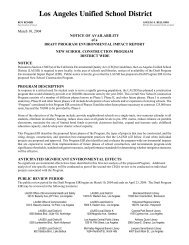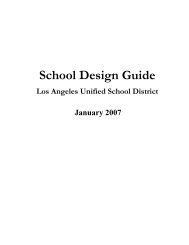Site-Specific Health and Safety Plan (HASP) - Laschools.org
Site-Specific Health and Safety Plan (HASP) - Laschools.org
Site-Specific Health and Safety Plan (HASP) - Laschools.org
Create successful ePaper yourself
Turn your PDF publications into a flip-book with our unique Google optimized e-Paper software.
LAUSD Proposed South Region High School #9 & Middle School #4<br />
14.0 SPILL RESPONSE PLAN<br />
14-1<br />
December 2006<br />
<strong>Site</strong> <strong>Specific</strong> <strong>Health</strong> & <strong>Safety</strong> <strong>Plan</strong> (<strong>HASP</strong>)<br />
Accidental spills, leaks, <strong>and</strong> releases may result when chemicals or potentially hazardous<br />
materials are brought onto or used on-site. If a spill or release occurs, the SHSO will take charge<br />
<strong>and</strong> initiate emergency procedures to protect the project personnel, the public, <strong>and</strong> the<br />
environment. The SHSO will contact the PM who will then contact the necessary LAUSD<br />
project personnel <strong>and</strong> other necessary personnel. If necessary, the PM will contact an emergency<br />
response contractor <strong>and</strong> the appropriate regulatory agencies.<br />
Prior to responding to a spill, site personnel <strong>and</strong> emergency response personnel will review the<br />
Material Data <strong>Safety</strong> Sheet (MSDS) with the SHSO <strong>and</strong> the Field Team Manager <strong>and</strong> identify<br />
the hazards so that proper precautionary measures can be taken, such as use of personal<br />
protective equipment. The emergency response personnel will eliminate the source <strong>and</strong> contain<br />
the spill by using absorbent material, patching/plugging <strong>and</strong>/or diking. Used absorbent materials<br />
will be properly disposed of as potentially contaminated/hazardous material. If evacuation is<br />
necessary to protect the public, appropriate project personnel, including local agencies, will be<br />
contacted.<br />
14.1 SPILL CONTAINMENT EQUIPMENT<br />
The following spill response equipment will be available:<br />
• Visqueen plastic sheeting<br />
• Absorbent materials in pillows, socks, sheets, or rolls<br />
• Patch <strong>and</strong> plug products<br />
• Protective Equipment <strong>and</strong> Clothing<br />
• Barrier tapes<br />
• 55-gallon Department of Transportation (DOT)-approved drums<br />
• Shovels, brooms, <strong>and</strong> dust pans<br />
14.2 SPILL CONTAINMENT PROCEDURES<br />
Upon discovery of a spill or leak, the affected area will be barricaded from unauthorized access<br />
to ensure safety of all personnel <strong>and</strong> the appropriate emergency response project personnel will<br />
be contacted immediately. The spill will be assessed with the SHSO <strong>and</strong> the Field Team<br />
Manager, MSDS <strong>and</strong> potential hazards reviewed <strong>and</strong> assessed, <strong>and</strong> the proper personal<br />
equipment <strong>and</strong> resources will be allocated to the spill response. If necessary, based on the<br />
severity of the spill, on-site personnel <strong>and</strong> nearby members of the public will be notified <strong>and</strong><br />
evacuated during clean-up. The spill will be contained by using absorbent materials <strong>and</strong> diking<br />
procedures. Diking of spills in conjunction with the use of absorbent material can make the<br />
clean up more efficient. Absorbent material can be placed in a dike configuration to provide<br />
temporary containment. If a leak is involved, a patch or plug will be placed on the container to<br />
stop further release of chemicals into the environment. The affected soil will be excavated,<br />
segregated, <strong>and</strong> characterized through sampling/analysis for proper disposition. The spill/release<br />
incident will be documented on the Spill Reporting Form by the SHSO.<br />
243







